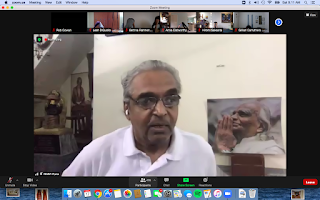There have been the classes close to home, with Marlene, Niren, Jocelyn, Stephanie and Jane. There have also been classes with Iyengar teachers in India: Zubin, Abhi, and now Prashant. He is the son of BKS Iyengar, brother to Gita, and head of the Institute in Pune.
Many students worldwide travel to Pune for the privilege of studying with the Iyengars and their senior teachers, however as many classes have moved online, these too have become easier to access.
I'd been looking forward to Preshant Iyengar's classes, originally scheduled in September/October, however he caught Covid and the sesssions were suspended indefinitely. Thankfully Prashant recovered quickly from the illness and sessions were soon rescheduled.
I overheard someone from YCT grumble about Prashant's classes. Practitioners either click with his unique style.... or don't. For these online classes, more than 400 students were signed up, so Prashant definitely does have his fans. Although a bit of a philosophic rambler, he encourages practitioners to experience the poses in new ways as he explores poses from different perspectives.
Just as in meditation, I found my mind wandering as it went exploring, off on a tangent of its own and then back again to listen to Prashant. There was ample opportunity to feel and experience the points being made.
Prashant shared that his father did not practise asana for 80 years, he explored asana; many asana were no longer available to him after 60 years or age, or 70 etc. The aim is not for perfect alignment or perfect asana.
Class was taught to all physical levels of capability including those with debilitating conditions who had to modify the poses to supine only. Still, the yoga could be done.
...
 Weekend One: We studied 4 poses: adho mukha savasana (downward dog), trikonasana (triangle), Utthita Parsvakonasana (side angle), and Setu Bandha Sarvangasana (bridge). Doing each with focus on the inhale, on the exhale, on the mind, on alignment, eyes open, eyes closed. He talked about "three sides of a coin" and how focusing on one while using the others to support can totally change the experience. He spoke of how inserting a pause into a sentence can change the entire meaning of a sentence, and so too, a pause in the pose can change its purpose. Using the poses, rather than doing the poses. The next day we focused on triangle pose, and he spoke about bringing your 'right mind,' not necessarily the full mind, to the practise. Strengthening will to choose the view.
Weekend One: We studied 4 poses: adho mukha savasana (downward dog), trikonasana (triangle), Utthita Parsvakonasana (side angle), and Setu Bandha Sarvangasana (bridge). Doing each with focus on the inhale, on the exhale, on the mind, on alignment, eyes open, eyes closed. He talked about "three sides of a coin" and how focusing on one while using the others to support can totally change the experience. He spoke of how inserting a pause into a sentence can change the entire meaning of a sentence, and so too, a pause in the pose can change its purpose. Using the poses, rather than doing the poses. The next day we focused on triangle pose, and he spoke about bringing your 'right mind,' not necessarily the full mind, to the practise. Strengthening will to choose the view.
Weekend Two: we did triangle pose for more than an hour, back and forth on each side for extended minutes, to experience the different states of activate, activated, activating.... from those three sides of the coin: body, breath, and mind. Prashant said he has a hashtag #prashantsteachingisconfusing but he doesn't mind. I almost burst out laughing by myself in the room as it resembled my passing thoughts. I didn't find them confusing per se, but would think a statement overly simple before falling into its depth. Like photography, the depth of perception that alters focus on the subject. As in other subjects, context is everything.
Because of yoga having three dimensions of body, mind and breath some practitioners may emphasize asana as for body; meditation for the mind; pranayama for breath. This may help to understand how one can be dominant in practice, but in reality all three are needed to work together in each discipline.
Experiences demonstrated that any asana can be done with a focus on a different aspect; sirsasana can become legasana or abdomasana or shoulderasana or breathasana or mindasana... Where you place mind the rest will follow, so do not try to place everything in dogmatic fashion but focus on one area or aspect and other parts of body often fall into place... don't try to master all or you may become the master of none
To explore: - In poses try to continue lengthening/deepening each exhalation.
Prashant spoke about how poses have different breaths and we observed breath in different positions and would then return to sitting to concentrate on how to bring that breath... for example take forward bending asana where you can feel the breath in the back and then sit upright and try to replicate.
Breath is a profound instrument. Sample valoma ah ah ah ah ee ee ee ee /ah ee ah ee ee ah ee ah. With this approach there are 335 variances of prana in any position using sounds of vowels and consonants. In his book, Pranayama: A Classical and Traditional Approach Prashant outlines more. This is a very complex subject which much has been written, taking four kriyas and five prana viyus and applying in different combinations and multiple ways.
For now I am content to explore just four modules using the placement of a bolster: horizontal under buttocks, then waist, then torso and then vertical under spine. Observe the involuntary breathe for awhile before gently voluntary exhale; then voluntaray inhale. Do not force or be aggressive.
To explore: valoma breath in asana.






No comments:
Post a Comment